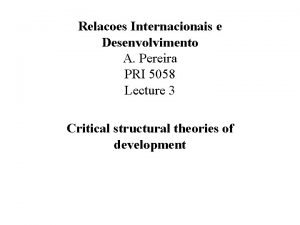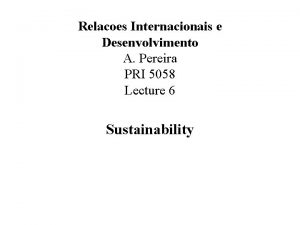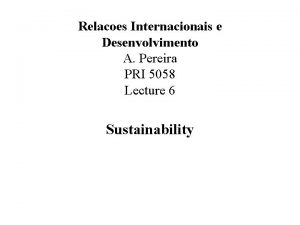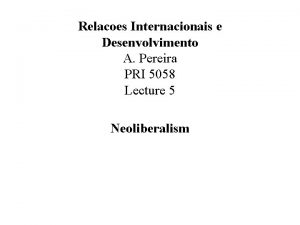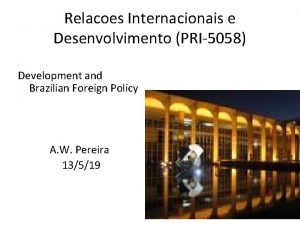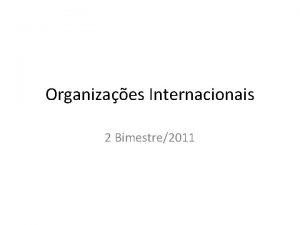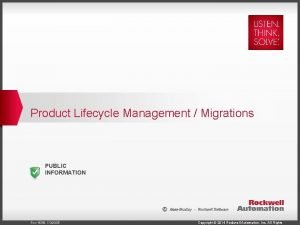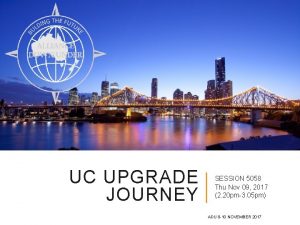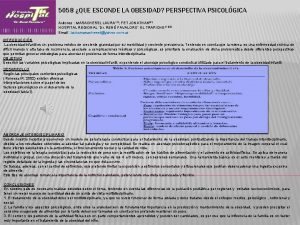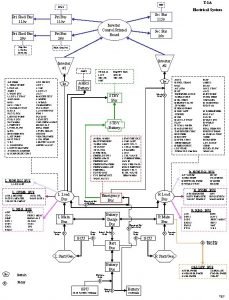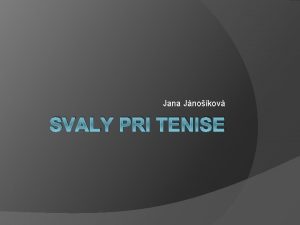Relacoes Internacionais e Desenvolvimento PRI 5058 Lecture 2









































- Slides: 41

Relacoes Internacionais e Desenvolvimento PRI 5058 Lecture 2 What is an “emerging economy”?

Unit 2 • What is an emerging economy? What are the origins of the term BRICs? Let’s look at the origins and development of the world economy before 2001 and what the BRICS signify today.

Outline • I The origins and development of the world market • II The first emerging economies: European expansion, British industrialisation and the beginning of national economies • III Novel features of the post-WW II development regime • IV Liberalization, globalization, financialisation, the emergence of the BRICS, and the backlash

I The Division of Labour • “The division of labour is limited by the size of the market” – Adam Smith • For most of world history, the size of the market was limited by the distance people or animals could walk in a single day • Towns were supported by hinterlands with a radius of between 10 -20 miles • In these microeconomies, specialisation was low – 90% of those economically active were likely to be peasants

I The Division of Labour (2) • With the development of shipping, trade increased, but it tended to be products with high value-to-weight ratios. Cheap, heavy, bulky items were generally not traded. Expensive, compact, light products generally were.

II European Competition Why did some European powers expand? – A bad neighbourhood: in 1500, Europe had about 500 political units; by 1900, this had been reduced to about 30. European powers expanded outwards, in part, because they feared that neighbouring states would become rich and powerful and take them over.

II European Competition • Internal: nobles vs kings vs merchants • Nobles: controlled the peasantry; wanted a barter economy with some money for luxuries; loose political confederations • Kings: wanted to unify microeconomies into absolutist states that could extract revenue and build strong armies; a monetized economy and a docile nobility; merchants who would lend them money

II European Competition • Merchants: wanted commercial alliances between city states; a monetized economy; guarantees for private property • European states forged compromises between these three forces. For example, Roman law recognizes both private property and the sovereign’s prerogatives. (In contrast, China was a centralized bureaucracy, and in Southeast Asia, decentralised trade networks prevailed)

II European Competition • The three-sided compromise between kings, nobles, and merchants gave way to a compromise between a central government bureaucracy, a landed aristocracy, and industrialists in the 19 th century • States and markets developed simultaneously

The emergence of European imperial and trading states: the Indian Ocean example • 1500 -1800 – Portuguese (Goa, Aden, Ormuz, Malacca) – Dutch – French – British domination • East India Company: a state-supported monopoly with an army that gained control over Indian trade and peasant surplus in the 19 th century

Areas of Portuguese influence in the 16 th century

A Portuguese nau, or carrack, of the 16 th century

III British Industrialisation and the Beginnings of National Economies • Canals and railroads unify micro-economies • The British textile industry develops an appetite for cotton • The U. K. moves up the technological ladder and moves from textiles as the leading sector to steel, steam engines, railways and manufactured goods

III The Nineteenth Century • Britain imports raw materials from all over the world and colonizes ¼ of the globe • It becomes a hegemon • The most important market for raw materials for the rest of the world • The most important producer of high tech manufactured goods • The most important lender and investor, and centre of finance • The rule-maker of the world economy and the ideologically dominant power (i. e. the Manchester School of free trade)


III The Nineteenth Century • British industrialisation generated “creative destruction” in the periphery • • Informal and formal colonialism The monetisation of economies An increase in production for the market The development of infrastructure An increase in private property A decline in local manufactures An increase in agricultural and mineral exports

III • New agricultural countries were big suppliers of raw materials to the UK in the 19 th C. They engaged in “Ricardian” development based on comparative advantage in agricultural and mineral commodities, and tended to be of European settlement: • • Canada Australia US New Zealand South Africa Argentina Uruguay Brazil

III • But the 19 th and early 20 th centuries was also a period of emulation of British industrialisation and, eventually, successful competition with Britain. This involved “Kaldorian” development – a move from agricultural and mineral commodities into manufacturing.

III • This was the first wave of “late developers” or emerging economies in the late 19 th and early 20 th centuries: – US – France – Germany – Russia – Japan

III • Post WW II late developers: – S. Korea – Taiwan – Hong Kong – Singapore – Brazil – Mexico

III • Late developers had what Alexander Gerschenkron called the “advantages of backwardness”: • Lower wages than those in the hegemon • They could “start at the top” – leapfrog several stages and go straight to the most concentrated, advanced forms of production • They could sometimes get assistance from the hegemon in the form of loans and investment

III • Late developers also had disadvantages • • lack of skilled and disciplined workers Smaller, weaker capital markets Lack of technology Lack of managerial skills and firms • The role of the state in late developers tended to be larger than in the UK, in part in order to make up for these disadvantages

Similarities? • The challenges facing leading developing countries today are similar to those facing late developers in the late 19 th/early 20 th centuries: • Borrow money and increase tax revenue • Move into higher value added, higher technology forms of production • Avoid exporting to flooded markets • Strike a balance between agriculture, manufacturing, and services • Maintain political order • Achieve some degree of political legitimacy

III • The challenge for managers of developing states is to extract resources from society without “killing the goose” that lays golden eggs – if the state takes too much, it kills the goose; if it takes too little, it might collapse. • States need markets to generate wealth and a source of tax revenue; markets need the coercive power of states to enforce property rights and contracts

IV The Post-World War II Development Regime • What was new? – Less liberal than the period of British hegemony (“embedded liberalism”) – Direct colonialism was largely dismantled – Less unilateral, more multilateral – TNCs

IV • Embedded liberalism – Bretton Woods, New Hampshire, USA, July 1944: 730 delegates from 44 Allied nations met in the Mount Washington Hotel to forge the Bretton Woods Agreements – Out of this came the IBRD (World Bank) and IMF – (Note: the new chief economist of the IMF is Gita Gopinath)

IV • Member of the US delegation Harry Dexter White: “…the absence of a high degree of economic collaboration among the leading nations will…inevitably result in economic warfare that will be but the prelude and instigator of military warfare on an even vaster scale. ”

IV Since 1971 • Economic turbulence increased (i. e. the first and second oil shocks, capital flight and currency shocks in the 1990 s, the financial crash of 2008 -9) • Growth has been lower in most developing countries • Liberalization and financialization have increased • US unilateralism has increased

IV Globalisation • “The closer integration of the countries and the peoples of the world which has been brought about by the enormous reduction of costs of transporation and communication, and the breaking down of artificial barriers to the flows of goods, services, capital, knowledge, and (to a lesser extent) people across borders. ” » Joseph Stiglitz, Globalization and its Discontents, Penguin 2002, chapter 1.

IV • The US position in the globalized world looks a bit like that of Great Britain’s in the early 20 th century • It has pushed for liberalization in areas of its comparative advantage (air transporation, capital goods, IT, telecommunications, construction, entertainment, finance, transportation, power, etc. )

IV • But it began to run trade deficits in the 1980 s, and these deficits (and its fiscal deficit) have now ballooned • They are financed by selling bonds • The US manufacturing base has eroded as manufacturing capacity has shifted to other locations in the world economy; the US economy has moved increasingly into finance and other services • US hegemony appears to be eroding

IV • Paradoxes of US hegemony: • 1) The US is the market of last resort for the rest of the world. But as it imports more and its manufacturing base erodes, its ability to continue to be the market of last resort declines. • 2) As the US pushes for the liberalisation of developing country economies, it makes them more vulnerable to crises • 3) The US wants other economies to liberalise while it practices “America First” economic nationalism at home

IV The BRICS • Goldman Sach’s economic team headed by Jim O’Neill wrote two influential reports. • Building Better Global Economic BRICs (2001). • Dreaming with BRICs (2003): predicted that of the G 6, only the US and Japan would be in the top 6 economies in 2050, and that the BRIC economies would replace Germany, the UK, France, and Italy.

An investment class becomes a political group • In 2009 at the suggestion of Russia, the first BRIC Summit was held (in Russia). • At the end of 2010, South Africa joined the group, turning BRIC into the BRICS. • The 11 th BRICS Summit will be held in Brazil in 2019. • In 2015 the BRICS created the New Development Bank with an initial commitment of capital of US$100 billion.

A snapshot of the BRICS countries Brazil China India Russia S. Africa Population (millions) 208 1, 404 1, 324 144 56 GDP (billions US$) 1, 793 11, 222 2, 274 1, 281 296 GDP per capita (US$) 8, 633 7, 996 1, 717 8, 898 5, 280 GDP growth (2011 -16) -0. 4% 7. 3% 6. 9% 0. 6% 1. 6%

A snapshot of the BRICS countries (2) Brazil China India Russia S. Africa Food/ agriculture 30% 4% 11% 5% n. a. Fuel/ minerals 16% 4% 18% 76% 40% Manufactur ing 54% 92% 70% 19% 15% Int’l Reserves (US$ billion) 365 3, 098 362 377 47 Export structure

A question • Do the BRICS countries want to change the global order or merely rise up within the hierarchy of states? To use a restaurant metaphor, do they want to change the menu, or just sit at the table?

IV Conclusions • “Emerging economies” have been emerging for hundreds of years, starting with the outward expansion of European states in the 15 th century and including Britain’s industrialization in the 19 th century. • European expansion and the shock between Europeans and indigenous people around the world created the global economy.

IV Conclusions (2) • Contemporary emerging economies, including the BRICS, are those whose size and dynamism add significantly to global growth and the movement towards a more multipolar world order. • There is disagreement about whether the BRICS represent a challenge to the global status quo or simply a reordering of the hierarchy within it.

For next week: unit 3 • How has capitalism been linked to imperialism? What is meant by the phrase the “development of underdevelopment”? • Come to class with the name of a Brazilian thinker in the “dependency” tradition, and his or her key idea about the world economy and Brazil’s relationship to it.

For next week: unit 4 • What is the post-developmentist critique of the international development regime? What is the alternative to the international relations of development for the postdevelopmentalists? • Come to class with the name of an organisation or movement that you think embodies post-developmentalism, and some reflection of how influential this organization
 Realismo nas relações internacionais
Realismo nas relações internacionais Relações internacionais ufmg
Relações internacionais ufmg Unidades internacionais
Unidades internacionais 01:640:244 lecture notes - lecture 15: plat, idah, farad
01:640:244 lecture notes - lecture 15: plat, idah, farad 1ª série em - projeto de vida - tecendo relações
1ª série em - projeto de vida - tecendo relações Escolas das relações humanas
Escolas das relações humanas Relacoes metricas
Relacoes metricas Nos x games brasil em maio de 2004
Nos x games brasil em maio de 2004 Homófonos
Homófonos Estilos de liderança chiavenato
Estilos de liderança chiavenato Relações ecológicas exercícios
Relações ecológicas exercícios Escolas das relações humanas
Escolas das relações humanas Esclavagismo é harmonica ou desarmonica
Esclavagismo é harmonica ou desarmonica Mal-entendido
Mal-entendido Relações intergeracionais significado
Relações intergeracionais significado Relações semânticas
Relações semânticas Relacoes
Relacoes Relações triangulares
Relações triangulares Organização ecológica
Organização ecológica Tg 45º
Tg 45º Relações ecológicas canibalismo
Relações ecológicas canibalismo Homografia exemplos
Homografia exemplos Escolas das relações humanas
Escolas das relações humanas Instrumentos de relações públicas
Instrumentos de relações públicas A escola das relações humanas
A escola das relações humanas Intertextual
Intertextual Protocooperação
Protocooperação Krystalický potah pevných povrchů při změně teploty
Krystalický potah pevných povrchů při změně teploty Kolotrag na kolniku
Kolotrag na kolniku Diretoria de desenvolvimento humano
Diretoria de desenvolvimento humano Bitka pri világoši
Bitka pri világoši Při úplném vybití akumulátoru by se přenesl
Při úplném vybití akumulátoru by se přenesl Bernoulliho rovnice
Bernoulliho rovnice Lze vodu uvést do varu již při 94 °c
Lze vodu uvést do varu již při 94 °c Zubor na slovensku
Zubor na slovensku živočíchy vo vode
živočíchy vo vode Zmierenie alebo dobrodružstvo pri obžinkoch zlaty fond
Zmierenie alebo dobrodružstvo pri obžinkoch zlaty fond Ravnanje z ljudmi pri delu
Ravnanje z ljudmi pri delu Homerjev naziv za grka
Homerjev naziv za grka Psicologia do desenvolvimento: uma perspectiva histórica
Psicologia do desenvolvimento: uma perspectiva histórica Desenvolvimento da ciência
Desenvolvimento da ciência Základy sústruženia
Základy sústruženia










































